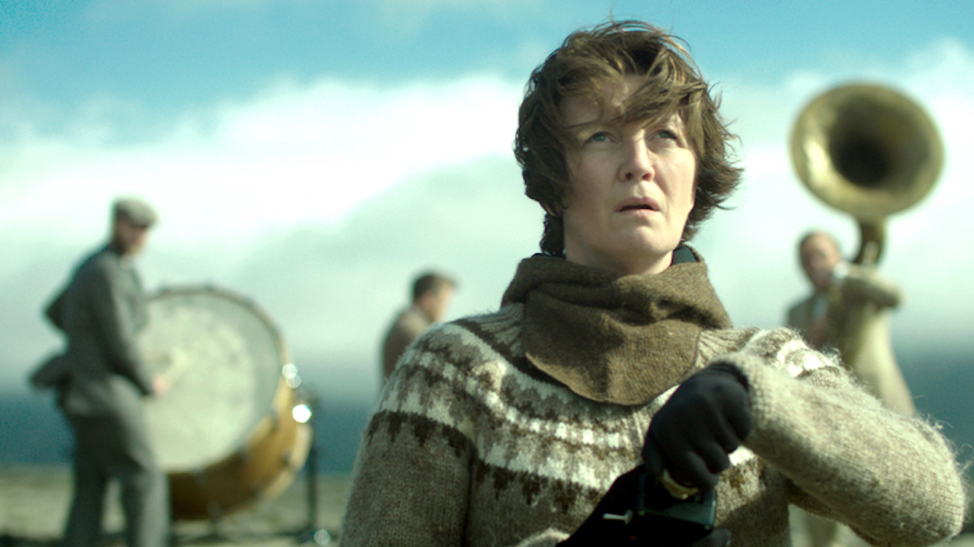MOVIE REVIEW: Woman at War
Woman at War, directed by Benedikt Erlingsson, was Iceland’s official submission for the 91st Academy Awards’ Foreign Film category, although it did not make the final cut. It’s certainly a novel, offbeat approach to an extremely serious topic that is increasingly on everyone’s minds these days, from the youth-led Sunrise Movement in the United States to Swedish teen activist Greta Thunberg. But no one would expect a woman like Halla (Halldóra Geirharðsdóttir) to be classified by the Icelandic government as an eco-terrorist, “The Woman of the Mountain,” nor to swim through icy streams and even camouflage herself with a sheep’s corpse to avoid detection. Assisted by crotchety livestock farmer Sveinbjörn (Jóhann Sigurðarson) and with a mole in the government (Jörundur Ragnarsson) conveniently a member of her choir, Halla has her vocation down to almost a science until she learns that her long-dormant application for the adoption of a Ukrainian orphan has been approved. Now Halla must decide whether to give up on the dream she’s held secret and close to her heart in order to protect the future for generations of young Icelanders.
While it’s not explicitly addressed as such in Woman at War, there’s a keen subtextual element of how Halla’s stature in Icelandic society as a completely average single middle-aged woman aids her cause, even as it means she’s been overlooked in other ways that may have caused her to become cynical. Halla had given up on being able to adopt a child because she was considered too old to be a proper mother; apparently Ukraine has different age requirements, and she’s now no longer excluded from adopting a child with nothing simply because she’s middle-aged. Woman at War tends, instead, towards more blunt social commentary, rightfully assuming that we are on Halla’s side, and Halldóra Geirharðsdóttir commands the screen with her steely resolve and expressive eyes.
While it never becomes preposterously cartoonish, the divide between Halla’s desperation to protect that beautiful Icelandic landscape and the government’s desire for control over it and over Iceland’s people becomes clearer and clearer over the course of the narrative. Assisted by the CIA, the government’s approach becomes more and more authoritarian, culminating in taking DNA samples from all people in the airport (while Halla is waiting in line to fly to Ukraine) to confirm that they are not the “Woman of the Mountain.” As they survey the hills in a helicopter looking for the mysterious terrorist, two patrollers gripe about the presence of sheep getting in their way, that “they” should do something about them. The government doesn’t care that there’s already an ecosystem here that has existed for thousands of years, as Sveinbjörn notes crabbily as the authorities attempt to get him to aid their hunt. “Why would I patrol the land they’ve taken from me?” he asks, denying both the explicit request and negating the social contract of surveillance culture that is now part and parcel of living in industrialized societies.
The premise of Woman at War grabs you immediately; the less-original aspects of the film also end up paying off in ways both expected and novel. When we meet Halla’s yogi twin Ása (also played by Geirharðsdóttir with thoroughly relaxed body language), simply being genre-savvy about the kinds of plots that involve identical twins (The Parent Trap, every soap opera ever) means that events at the tail end of the film don’t come across as a surprise, but almost as justification for including the character of Ása in the first place. The incorporation of the soundtrack music of Woman at War as semi-diegetic is also a clever way to defuse tension in some of the more suspenseful scenes, and to make the film feel less preachy and more inventive; notably, the musicians switch from the band to a trio of singers in Ukrainian traditional dress whenever Halla thinks about the little girl waiting for her in Ukraine, leading to some entertaining musical juxtapositions.
Often, popular media that incorporates social commentary brings up important points and then casts them aside, either because they’re too preachy or are espoused by the villain, making them narratively radioactive. Orm from Aquaman is right about the oceans being polluted, but he’s evil and therefore his point is negated; Killmonger from Black Panther is right about anti-Black racism and Wakanda’s duty to the Black diaspora but is the bad guy; the feminist group in Veronica Mars season three are right about college campus rape culture, but are the villains because it turns out they were lying for evil man-hating reasons. So it’s refreshing to see more and more films these days where justice and equity aren’t punchlines or strawmen, but are actively advocated for by the narrative. (I’m thinking of Sorry to Bother You, which is ironic about a lot of things but deadly serious about labor rights.) Woman at War is a film that takes its core issue seriously, but also respects the audience enough to veer away from PSA territory.

Comments
Post a Comment